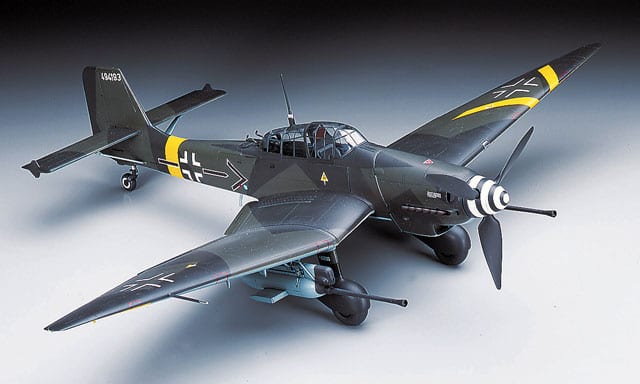ST25 – 1/32 JUNKERS Ju87G STUKA «KANONENVOGEL»
60,50€
Hay existencias

*Please check our Privacy Policies to see how to we use your personal data.
*Por favor revisa nuestra Política de Privacidad para ver como tratamos tus datos personales
Scale … 1:32
Part number ……… ST25
Number of parts: 167
Overall length of model … 352mm Overall width of model … 474mm
The new Ju87 D-series began planning in early 1940. The oil cooler is attached to the underside of the nose, and the radiators are installed on both sides of the underside of the main wing, resulting in a cleaner cowling shape for the nose than the B series, and a streamlined windshield and main landing gear cover. It became an aerodynamically superior aircraft. We also increased the on-board fuel capacity and added bulletproof steel plates around the occupants.
Although it is a D type that was introduced to each front, it was clearly inferior to Allied fighters at a maximum speed of about 400 Km / h. However, there was still room for activity on the Eastern Front, where there are few high-performance Allied fighters.
The D-5 is equipped with a detachable main landing gear with an extended wing tip as a countermeasure against the wing loading that has increased to near the limit due to repeated repairs, and the dive brake was removed in the latter model.
The G-1 was an anti-tank attack aircraft developed for Soviet tank attacks and was equipped with two Flak 18 37mm cannons for anti-tank attacks under the main wings. In 1942, the plan to carry out a Soviet tank attack with Stuka was realized, and in December, a prototype machine with a cannon under the wing was manufactured and tested based on the Ju87D-1. The results of this test were very satisfying, and it was confirmed that a 37mm gun could be incapacitated with a single shot by hitting the engine part at the rear of the tank. Immediately, the G-1 type was mass-produced based on the Ju87D-3.
Based on the D-5’s fuselage, the G-2 had a 37mm cannon attached to the underside of both wings, like the G-1, and the 20mm cannon on the wings had been removed. The operation areas of G-1 and G-2 were mainly on the Eastern Front, and they were effective against Soviet anti-tank attacks.
《Ju87G-2 Stuka data》
Crew: 2 people, total length: 11.50m, total width: 15.00m, total height: 3.84m, engine: Jumo211J-1 lift output: 1,400hp Armed: 37mm cannon x 2
Escala … 1:32
Número de pieza ……… ST25
Número de piezas: 167
Longitud total del modelo … 352 mm Anchura total del modelo … 474 mm
La nueva serie Ju87 D comenzó a planificarse a principios de 1940. El enfriador de aceite está unido a la parte inferior de la nariz y los radiadores están instalados en ambos lados de la parte inferior del ala principal, lo que da como resultado una forma de capota más limpia para la nariz que la serie B, y un parabrisas aerodinámico y una cubierta del tren de aterrizaje principal. Se convirtió en un avión aerodinámicamente superior. También aumentamos la capacidad de combustible a bordo y agregamos placas de acero a prueba de balas alrededor de los ocupantes.
Aunque es un tipo D que se introdujo en cada frente, era claramente inferior a los cazas aliados a una velocidad máxima de unos 400 Km / h. Sin embargo, todavía había espacio para la actividad en el frente oriental, donde hay pocos cazas aliados de alto rendimiento.
El D-5 está equipado con un tren de aterrizaje principal desmontable con una punta de ala extendida como contramedida contra la carga del ala que ha aumentado hasta cerca del límite debido a reparaciones repetidas, y el freno de inmersión se eliminó en el último modelo.
El G-1 era un avión de ataque antitanque desarrollado para ataques de tanques soviéticos y estaba equipado con dos cañones Flak 18 de 37 mm para ataques antitanques debajo de las alas principales. En 1942, se realizó el plan para llevar a cabo un ataque de tanques soviéticos con Stuka, y en diciembre, se fabricó y probó un prototipo de máquina con un cañón debajo del ala basado en el Ju87D-1. Los resultados de esta prueba fueron muy satisfactorios y se confirmó que un cañón de 37 mm podría quedar incapacitado con un solo disparo al golpear la parte del motor en la parte trasera del tanque. Inmediatamente, el tipo G-1 se produjo en masa basado en el Ju87D-3.
Basado en el fuselaje del D-5, el G-2 tenía un cañón de 37 mm unido a la parte inferior de ambas alas, como el G-1, y el cañón de 20 mm en las alas había sido eliminado. Las áreas de operación de G-1 y G-2 estaban principalmente en el Frente Oriental, y fueron efectivas contra los ataques antitanques soviéticos.
《Datos de Ju87G-2 Stuka》
Tripulación: 2 personas, longitud total: 11,50 m, anchura total: 15,00 m, altura total: 3,84 m, motor: Jumo211J-1 Potencia de elevación: 1400 CV Armado: cañón de 37 mm x 2





 Solicitud de ficha producto tipo SDS / Seguridad de producto
Solicitud de ficha producto tipo SDS / Seguridad de producto